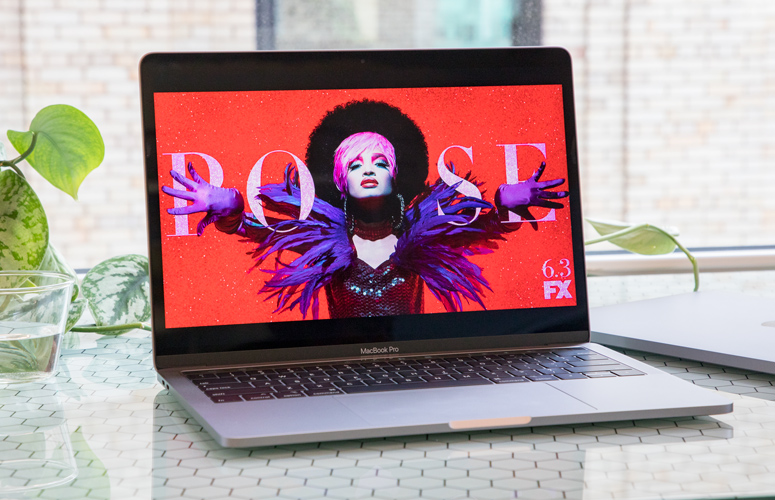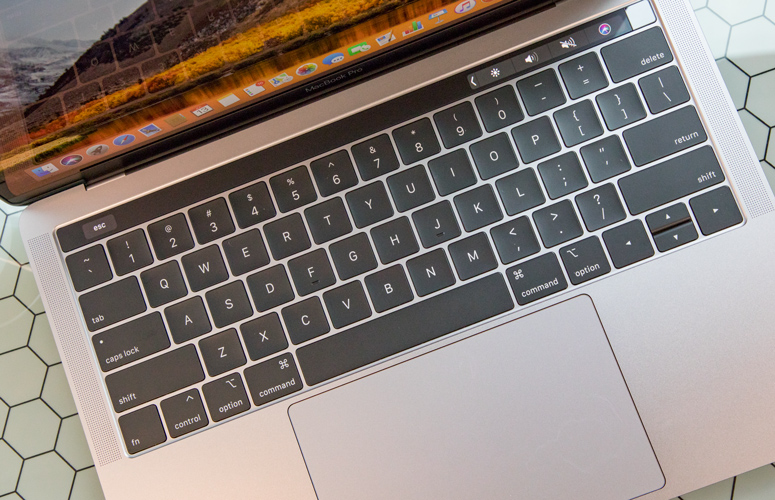Apple MacBook Pro (2018) vs. Dell XPS 13: Face-Off!
The new 2018 MacBook Pro is here, and it brings renewed competition to our favorite overall laptop, the Dell XPS 13. Apple has refreshed its flagship laptop with upgraded internals, vital changes to the keyboard and several other minor improvements. These two powerhouse machines are undoubtedly excellent options, but which one offers more for your money?
Here is how the new 13-inch MacBook Pro (2018) stacks up against both the Core i5, 1080p and Core i7, 4K versions of the Dell XPS 13.
Apple MacBook Pro (2018) vs. Dell XPS 13 9370
| Row 0 - Cell 0 | MacBook Pro 13-inch | Dell XPS 13 (Core i5, 1080p) | Dell XPS 13 (Core i7, 4K) |
| Price | $2,499 | $1,199 | $2,499 |
| Colors | Silver, Space Gray | Platinum Silver/Black, Rose Gold/Alpine White | Platinum Silver/Black, Rose Gold/Alpine White |
| Display | 13.3 inches (2560 x 1600 pixels) | 13.3 inches (1920 x 1080 pixels) | 13.3 inches (3840 x 2160 pixels) |
| CPU | Intel Core i7-8559U | Intel Core i5-8250U | Intel Core i7-8550U |
| RAM | 16GB | 8GB | 16GB |
| SSD | 512GB SSD | 256GB SSD | 1TB SSD |
| Keyboard Travel | 0.6 mm | 1.2 mm | 1.2 mm |
| Ports | 4 Thunderbolt 3, headphone jack | 2 Thunderbolt 3, USB-C 3.1, microSD card, headphone jack, lock slot | 2 Thunderbolt 3, USB-C 3.1, microSD card, headphone jack, lock slot |
| Webcam | 720p | 720p | 720p |
| Size | 12 x 8.4 x 0.6 inches | 11.9 x 7.8 x 0.46 inches | 11.9 x 7.8 x 0.46 inches |
| Geekbench 4 | 17,572 | 13,254 | 14,180 |
| Battery Life (hrs:mins) | 8:23 | 12:37 | 8:23 |
| Weight | 3 pounds | 2.65 pounds | 2.65 pounds |
Design
Dell trimmed the fat off the aging XPS 13 this year with the introduction of a brand-new design. Sleeker, slimmer and all-around sexier, the 2018 edition is one of the most gorgeous laptops on the market. While those visual updates are welcome, it's the InfinityEdge display that continues to define the successful Ultrabook line. The bezel-less design provides a level of immersion you don't get with the MacBook Pro. The downside is that the webcam is still in an awkward location: underneath the display.
The MacBook Pro's practical, industrial design is unchanged from its predecessor. There is nothing glaringly wrong with it — there's even a handy Touch ID fingerprint sensor on this Touch Bar model — but a lack of innovation is starting to weigh the MacBook Pro down, both figuratively and literally. At 3 pounds and 12 x 8.4 x 0.6 inches, the 13-inch MacBook is heavier and larger than the 2.65-pound and 12 x 7.9 x 0.5-inch XPS 13. This year, the 4K XPS 13 isn't substantially heavier than its 1080p counterpart.
Sign up to receive The Snapshot, a free special dispatch from Laptop Mag, in your inbox.
These aluminum laptops come in two color options. If you're feeling bold, opt for the XPS 13's fresh white-and-rose-gold color scheme, which features a woven glass-fiber palm rest and a stain-resistant coating. There is also a traditional silver-and-black model with a soft-touch carbon-fiber deck. The MacBook Pro is available in two finishes: Silver and Space Gray.
Winner: Dell XPS 13
Ports
These portable laptops are predictably short on ports. Disappointingly, a full-size USB port is missing from both the XPS 13 and the MacBook Pro, which means you'll need a dongle to plug in your legacy peripherals. Apple went all out on Thunderbolt 3, including four (two on each side) on the MacBook Pro.
The XPS 13 has two fewer Thunderbolt 3 but offers a wider variety of ports, including a USB-C 3.1, a microSD card slot and a Kensington lock slot. Both laptops have headphone jacks.
Winner: Dell XPS 13
Display
Don't count out the 1080p display on the base model of the XPS 13. The panel covers an impressive 117 percent of the sRGB color gamut and reaches a maximum brightness of 372 nits.
But those results are edged out by the Retina display on the MacBook Pro, which is both brighter and more colorful. The MacBook Pro's panel covers 119 percent of the sRGB color gamut and reaches 439 nits of maximum brightness. It's also sharper, with a resolution of 2560 x 1600.
The MacBook Pro's display may have the edge over the 1080p model, but the display on the 4K XPS 13 is even more gorgeous and supports touch. The high-end XPS 13's display has a resolution of 3840 x 2160 and covers a whopping 130 percent of the sRGB color gamut, making it more colorful and sharper than the MacBook Pro. However, its peak brightness of 415 nits is a tad dimmer than Apple's laptop.
The Dell XPS 13 models have the advantage of a bezel-less design, while the new MacBook Pro features True Tone, which dynamically changes the white balance depending on the color temperature of your room.
Winner: Draw
Keyboard and Touchpad
While neither laptop has a particularly good keyboard, the Dell XPS 13 has greater key travel despite its thinner chassis. The XPS 13's 1.2 millimeters of key travel is closer to our 1.5-to-2-mm preference, and offered a decent typing experience in our testing.
We can all breathe a sigh of relief — the MacBook Pro's revamped keyboard is an improvement over the previous edition's. Not only are the keys quieter, but there's also now a thin, rubberized membrane beneath the key caps that prevents dust and grime from getting in. It's a step forward, but not necessarily enough to overcome the shallow key travel (0.6 mm).
We had no problems using the touchpad on either of these laptops to execute gestures. However, at 5.3 x 3.3 inches, the MacBook Pro's touchpad is much larger than the 4.2 x 2.3-inch touchpad on the XPS 13.
Winner: Dell XPS 13
Performance
The MacBook Pro we tested was configured with an 8th Gen Intel Core i7 processor, 16GB of RAM and a 512GB SSD, whereas the 1080p XPS 13 was equipped with midrange components, including an Intel Core i5-8250U CPU, 8GB of RAM and a 256GB SSD. The 4K XPS 13's Intel Core i7-8550U CPU, 16GB of RAM and 1TB PCle SSD compare more favorably to the MacBook Pro's specs.
As expected, the MacBook Pro outperformed the Core i5 XPS 13 in most tests, and was closely matched by the i7 XPS 13. After running the software update Apple released to address throttling concerns, the MacBook Pro scored a 17,572 on the Geekbench 4 test, which measures overall performance. The Core i5 XPS 13 scored 13,254, and the Core i7 XPS 13 also fell short of the MacBook Pro, with a score of 14,180.
The MacBook Pro completed our Microsoft Excel test, which involves matching 50,000 names with their corresponding addresses, in 1 minute and 16 seconds. The Core i5 XPS 13 edged it out by 1 second, finishing the test in 1:15. The Core i7 XPS 13 was the quickest, at 1:08.
The MacBook Pro's SSD is the fastest we have ever tested. It turned in a blistering write speed of 2,682 megabytes per second on the Blackmagic disk speed test. The same test isn't available for Windows, but the Core i7 XPS 13 reached a much lower score of 1,208 MBps on the CrystalDiskMark benchmark.
MORE: Which Laptop CPU is Right for You?
It took the 2018 MacBook Pro 14 minutes and 47 seconds to finish the demanding HandBrake video editing test, which involves transcoding a 4K clip to 1080p. That's much faster than both the i5 XPS 13 (18:17) and i7 configuration (16:00).
The XPS 13 is better for gaming than the MacBook Pro. The MacBook's Iris Plus Graphics 655 ran Dirt 3 at a playable-but-lowly 46.9 frames per second on medium settings, whereas the Intel UHD 620 GPU in the Core i5 XPS 13 played the same game at a respectable 56.7 fps. The Core i7 XPS 13 with the same graphics card returned a smooth 66.9 fps.
Winner: Apple MacBook Pro
Battery Life
The XPS 13 with the lower-resolution, 1080p display just wouldn't give up in our battery test, which involves continuous web surfing over Wi-Fi at 150 nits of brightness. The XPS 13 lasted an impressive 12 hours and 37 minutes. After the update, the MacBook Pro's battery endured for 8 hours and 23 minutes — a good, if somewhat disappointing, result.
MORE: Laptops with the Longest Battery Life
With a 4K display, the touch-screen XPS 13 needs to power more pixels than its 1080p counterpart. The result is a huge hit to battery life. It equalled the MacBook Pro in our battery life test, enduring only 8 hours and 23 minutes.
Winner: Dell XPS 13
Value
The XPS 13 with a nontouch, 1080p display starts at $999 for an Intel Core i5 CPU, a 256GB SSD and 4GB of RAM. The unit we reviewed came with our recommended minimum of 8GB of RAM and a 256GB SSD for $1,199.
The new 13-inch MacBook Pro with Touch Bar configured with an Intel Core i5, 8GB of RAM and a 256GB SSD costs a steep $1,799. That's a resounding $600 more than an XPS 13 with similar specs.
The decked-out versions of both of these premium laptops MSRP at $2,499. However, when you compare the specs, the Dell XPS 13 offers more. The XPS 13 comes with a 4K, touch-screen display and a 1TB SSD. For the same chunk of cash, the MacBook has a lower-resolution, 2560 x 1600 display and only a 512GB SSD.
Winner: Dell XPS 13
Overall Winner: XPS 13
| Row 0 - Cell 0 | MacBook Pro 13-inch | Dell XPS 13 |
| Design | Row 1 - Cell 1 | Row 1 - Cell 2 |
| Ports | Row 2 - Cell 1 | Row 2 - Cell 2 |
| Display | Row 3 - Cell 1 | Row 3 - Cell 2 |
| Keyboard/Touchpad | Row 4 - Cell 1 | Row 4 - Cell 2 |
| Performance | Row 5 - Cell 1 | Row 5 - Cell 2 |
| Battery Life | Row 6 - Cell 1 | Row 6 - Cell 2 |
| Value | Row 7 - Cell 1 | Row 7 - Cell 2 |
| Overall | 2 | 6 |
In most categories, the MacBook Pro lands somewhere in the middle of the 1080p and 4K XPS 13 models. It has a better display than the 1080p XPS 13, but it isn't as sharp or as colorful as the 4K version of Dell's laptop. And while the MacBook's battery life is about the same as the 4K XPS 13's, it's nowhere near the impressive 12+ hours the 1080p model pulled off.
In the end, the Apple MacBook Pro is undone by its less-comfortable keyboard and weaker graphics performance. For these reasons, the Dell XPS 13 remains the better overall laptop for the money.
Credit: Laptop Mag
Phillip Tracy is the assistant managing editor at Laptop Mag where he reviews laptops, phones and other gadgets while covering the latest industry news. After graduating with a journalism degree from the University of Texas at Austin, Phillip became a tech reporter at the Daily Dot. There, he wrote reviews for a range of gadgets and covered everything from social media trends to cybersecurity. Prior to that, he wrote for RCR Wireless News covering 5G and IoT. When he's not tinkering with devices, you can find Phillip playing video games, reading, traveling or watching soccer.










